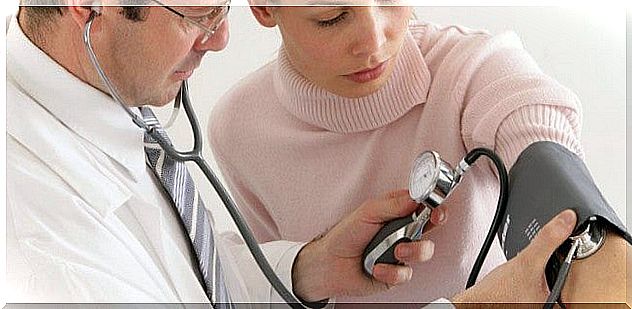Do You Know White Coat Hypertension?

White coat hypertension is also known as isolated clinical or office hypertension. The person who suffers from it has blood pressure values higher than normal parameters when the measurement is performed in a clinical setting (clinics, health centers, hospitals, etc.).
However, when stress is measured outside the clinical setting, the values are within a normal range. Despite the fact that white coat hypertension has been recognized as a pathology for many years, some aspects still remain unclear. But first of all, let’s look at some key concepts to better understand the phenomenon of white coat hypertension.
What is blood pressure?
Blood pressure is the force exerted by blood against the wall of the arteries. This pressure is essential for the blood to circulate through the blood vessels and provide oxygen and nutrients to all the body’s organs so that they can function properly.
Blood pressure has two components:
- Systolic blood pressure: corresponds to the maximum value of blood pressure in systole (when the heart contracts). It refers to the pressure effect exerted by the blood ejected from the heart on the wall of the vessels.
- Diastolic blood pressure: corresponds to the minimum value of blood pressure when the heart is in diastole or between heartbeats. It depends mainly on peripheral vascular resistance.

Blood pressure abnormalities
Two abnormalities or dysfunctions in blood pressure can occur:
- Arterial hypertension: refers to an increase in blood pressure, either systolic or diastolic. Hypertension, along with high cholesterol and smoking, is one of the three most important and modifiable cardiovascular risk factors.
- Arterial hypotension: involves the decrease in blood pressure below normal limits. It usually manifests itself in the form of fatigue and dizziness.
White coat hypertension
As we said before, white coat hypertension occurs in some people when they go to hospitals or related places, such as medical consultations.
We can define white coat hypertension as an alert reaction when the patient is in the presence of a doctor. This alert reaction is a complex and stereotyped response to a potentially threatening emotional stimulus. This reaction is characterized by an increase in blood pressure and heart rate when the doctor is about to take a patient’s blood pressure. That is, it is triggered by the presence of the doctor during the measurement.
It is curious that if the person measuring blood pressure is a friend, relative or the patient himself, this alert reaction does not occur. Nurses can trigger the same effect, but to a lesser extent. The place where the procedure is performed also influences the appearance of white coat hypertension, as we have seen before.

What are the criteria for diagnosing white coat hypertension?
The European Society of Cardiology (ESC) has suggested the following diagnostic criteria for the management of arterial hypertension:
- Blood pressure values greater than 140/90 mmHg measured in the office during three different visits.
- At least two out-of-office measurements with blood pressure less than 140/90 mmHg.
- Absence of damage to target organs.
- Average ABPM-day less than 135/85 mmHg. ABPM refers to ambulatory blood pressure monitoring.
What characteristics do patients with white coat hypertension possess?
Patients prone to white coat hypertension have the following characteristics:
- Office blood pressure 140/90 mmHg to 159/99 mmHg.
- Female gender
- Non-smokers.
- Recently diagnosed arterial hypertension.
- Absence of left ventricular hypertrophy. Left ventricular hypertrophy refers to when the heart muscle is thickened, when the walls of the heart are thick. It is generally a “consequence” of high blood pressure.
The heart of the hypertensive patient has to “pump” the blood with greater effort, since it circulates at higher pressure. If this is maintained over time (usually years), the heart muscle has to “fatten” (hypertrophy) to be able to push the blood with more force with each beat.

Why does white coat hypertension and white coat effect occur?
So far, no mechanism has been clearly identified to explain why this phenomenon occurs. However, some evidence has been found that we will present below:
Increase in blood pressure in the clinical setting due to an alert reaction
We all suffer an increase in blood pressure and heart rate when faced with a stimulus that we perceive as threatening (stressful). For people with the effect of the white coat, this threatening or stressful stimulus would be the clinical context, so that when exposed to it, they would experience the physiological changes characteristic of a stress response. Thus, this hypertension would not be caused by cholesterol or another physiological cause, but would be caused by stress itself.
Thus, this effect is the result of a conditioned response to the clinical or hospital environment and not to the stimulus of the white coat. We understand a conditioned response to be a reaction or a learned reflex response to a stimulus. It receives the name of “conditioned” because it appears after the condition of learning has been given, of the experience of the association of stimuli.
The salivary response of Pavlov’s famous dog is called conditioned only when the dog has learned to give it after a stimulus that did not naturally provoke it, such as the sound of the bell. He has it precisely because he has experienced its association or temporary link with the presence of food in the mouth, which did naturally provoke this response.
The conditioned responses are thus manifested by the organism in the face of so-called conditioned stimuli. In the subject at hand, the conditioned stimulus would be the clinical or hospital environment and not the white coat. The answer would be an increase in the activity of the sympathetic autonomic nervous system and a decrease in the activity of the parasympathetic autonomic nervous system.
The sympathetic autonomic nervous system is responsible for the symptoms of nervousness, restlessness, stress, etc. On the other hand, the parasympathetic autonomic nervous system takes care of the opposite. It is responsible for the sensations of tranquility and relaxation.
Thus, in white coat hypertension there is a greater activity of the sympathetic nervous system, which causes an increase in heart rate, blood pressure, and tachycardia. However, the evidence indicates that the increases in heart rate are caused especially by the reduction of the activation of the parasympathetic system.
The white coat effect vs white coat hypertension
The terms “white coat effect” and “white coat hypertension” are mistakenly used synonymously. The white coat effect refers to the transient rise in blood pressure that occurs as an alert reaction. This alert reaction is triggered primarily by the clinical environment.
For its part, with white coat hypertension we refer to the clinically hypertensive patient in the doctor’s office. On the other hand, this patient’s blood pressure values remain within normal ranges during his daily activities. The white coat effect is not related to the level of “baseline blood pressure” or outside the medical setting and can occur in patients with or without hypertension.
As we have seen, white coat hypertension is essentially generated and modulated by psychological factors. The person experiences an increase in blood pressure and heart rate before a conditioned stimulus, such as the hospital or clinical environment. In this way, the treatment must also be psychological.
Bibliographic references:
Morrales Rueda, A., Ortega García A., Sierra Santos L. Prevalence of white coat hypertension during perimenopause . Medifam, 2001.









